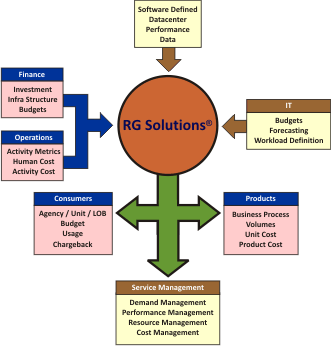IT Linked to Business
Provides for the
designation of business
cost centers and controls
the cost allocations to
these cost centers through
ABC techniques. This
ensures that IT service
costs are linked to desired
business functions. The
result is the ability to
measure the value of IT
services provided to the
business.
Consumers & Products
IT services deliver
information to business
consumers and also
provides service products
to internal or external
customers. Viewing IT
service delivery in these
terms allows for the linking
of IT service costs to
specific business
processes.
Service Management
IT Service Management
depends on the ability to
understand and manage
demand. Solid and
consistent demand metrics
allows IT to provide
optimum performance,
effective resources, and
reduce the cost associated
with the IT services.
Solutions:
Intelligent Costing

Resource Catalog
Intelligent costing requires intelligent data. For this reason, it is necessary to maintain an inventory of
resources that is being used for the delivery of IT services. Included in the inventory are the
associated processing profiles, related investment and operational costs, and the linking of the direct
costs to the resources. Information in the catalog can be used for other business related actions such
as benchmarking, price/cost analysis, budget preparation, etc.
RG Solutions® fully supports the use of a Resource Catalog for its processing. This catalog forms
the basis of all processing and defines the various relationships between resources, resource sharing,
and the costs related to all processing. The contents and configuration of the catalog is fully under the
control of the user, and the user can not only edit inventory information, but can automatically update
information that is based on actual system processing.
Usage Based ABC Model
The cost calculations within RG Solutions® are based on a metered usage model using ABC methods
for allocations. This metered model accommodates different systems, OS platforms, and
configurations. The model also uses a SOA framework for the identification and calculation of isolated
costs, shared costs (i.e. databases, web servers, etc.), consumer costs (usage), and product costs
(i.e. unit cost, volumes, etc.).
The user has complete control over the costing strategy that is used. The use of hierarchal Cost
Pools links consumer processing to one or more contracts or expense groups that may or may not be
shared. Strategic to Cost Pools is the inbuilt ability to forecast future workloads and have automatic
cost calculations, even if the associated Cost Pools change. For even greater control over the costing
process, the user has the ability to set the rates for the individual elements of the costing process
regardless of the IT service.
Integrated Data
The basis of rock solid cost allocation is
the ability to collect and maintain IT
performance information. The core
foundation of RG Solutions® is based on
Capacity Planning principals and as such
knows how to automatically collect,
process, and maintain this data. Include
the ability to integrate external financial
and operational data and you have the
capability to deliver detailed IT service
data in the business’s native terms.
The user determines how shared costs
are applied, directed, and accumulated
for similar lines of business, products, or
other business metrics. The hierarchical
structure of the internal data allows for
quick analysis of business units, products,
value chains, or any other business
metrics. Data views have a one-to-one
relationship between consumer cost and
the underlying technical data. Forecasting
can be done by the consumer in business
terms and then accurately translated into
technical requirements.


